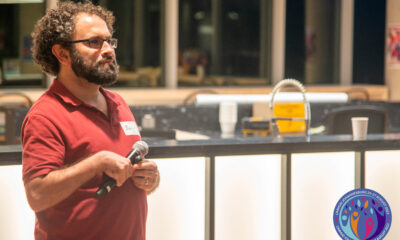
Featured Item

Why ChatGPT can be a teacher’s best friend
When teachers arrived back to school this year, they found “their world had been turned upside down” with ChatGPT having infiltrated their classrooms, according to Shaun Swartz, chief executive of Learnalot and GED Africa.
However, Swartz says teachers need to accept this new technology and use it to enhance learning.
Swartz, whose company has worked with Artificial Intelligence (AI) in education for many years, spoke to teachers at Yeshiva College on 2 February to help them navigate the technology and understand how to use it to enhance their teaching.
He believes teachers needn’t fear this highly advanced software, which they can take advantage of within their classrooms.
“Half of [the students] are already using ChatGPT, and half of them will be soon, so you have to accept it,” Swartz told the more sceptical teachers.
Teachers are concerned about the software’s use to write essays. Swartz explained that AI has the ability to comb through all the data and information made available (in the case of ChatGPT, the entire internet) and formulate a relevant response to a specific prompt by synthesising that information. As a result, the work cannot be seen as plagiarism. However, to the relief of many teachers, Swartz explained that, though traditional plagiarism checkers are unable to detect the use of ChatGPT, there are programmes that check specifically for the use of AI in writing, and these programmes would become more advanced as AI writing became more widespread.
This kind of software isn’t always 100% accurate, he said. Instead, his solution to the problem of students letting ChatGPT do all the work for them is to give students assignments that will necessitate them having to ask ChatGPT specific questions to produce the desired answer, which enhances critical thinking skills.
“Getting the right answer and the right information from the system is all about asking the correct questions,” he said. “Instead of giving them the questions, [teachers should] tell the students what they need to achieve. We don’t care what the paragraph looks like at the end, because that’s something that ChatGPT can write for them, but if you ask the student to tell you what they asked ChatGPT to do in order to produce the answer, that’s something that they can’t do without thinking”.
Swartz then gave a series of test prompts to ChatGPT based on what the group of teachers wanted to observe. In doing this, they were able to see the kind of answers the AI could produce, and what its shortcomings were.
Swartz asked it to generate a paragraph in English, and then translate it into Afrikaans, and then from Afrikaans to Hebrew. The teachers observed that, though there were imperfections, the grammatical structure was more correct than if they had been using something like Google Translate, which is already popular with students.
A couple of other areas where the software seemed to fall short were prompts that required humour and those that discussed current affairs after 2020, which ChatGPT is restricted from discussing.
When it came to subjects such as maths and science, teachers were concerned about students inputting various equations and formulas into ChatGPT and being able to generate an answer without showing the work done in figuring it out or any effort on the students’ behalf.
“Before this, it was calculators,” said Swartz. The advantage of AI, he explained, is that students can obtain the answer, as well as all the relevant steps taken to get to this answer. “Though some students struggle to understand the methods given in their syllabus, ChatGPT can give 10 different explanations as to how the answer was obtained,” allowing students to understand things in a way that better suits them.
Teachers haven’t considered how they can use ChatGPT to assist them to teach, Swartz said. He described just how many tedious tasks can be “handed over” to ChatGPT in order for teachers to spend less time planning and more time interacting with students.
For example, just as a student can get answers to their maths questions, teachers can use the software to generate hundreds of questions, as well as model answers and working-out. The teacher can specify the topic and level of difficulty, tailoring the questions to the specific skill they want to test. The same thing goes for any other subject. A teacher can ask for a set of questions and answers for a science exam on light waves, a list of creative writing prompts for Grade 9, or any other assessment they wish to set for their class.
There are some things that a computer is just able to do a lot more efficiently than us, Swartz said. For example, a person can spend hours working on computer code, just for the whole thing to be corrupted by a tiny human error. In the past, one would have to go back and scan the entire block of code to find out where the error took place. Now, one can simply copy and paste that code into ChatGPT, which can locate the problem in seconds.
“It’s vital for teachers to view ChatGPT as a tool that can assist in learning rather than an impediment,” said Swartz. “Microsoft is investing billions of dollars into this application, which means that it’s only going to get better, easier to use, and it’s going to be integrated into its search facilities. We must start accepting that students will use it, and we have to rethink the way we ask questions and assess them.”











Jessica
February 13, 2023 at 12:16 pm
Never, ever allow ChatGPT near your children. It is a proven propaganda tool for international socialism, pro-BDS, programmed to exclude opposing democratic viewpoints and specifically targets children for brainwashing by means of all sorts of wokery. And be sure that it will smear Israel by stealth.